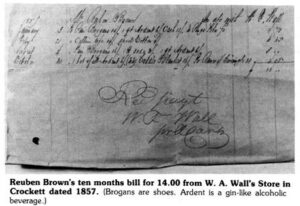Rueben Brown

Rueben Brown Family History

When Reuben and Sarah Brown settled on San Pedro Creek in 1834, did they dream their descendants would still have the land 150 years later? Did they know their descendants would gather annually in June, on their land, for Memorial Services at the cemetery where they would be buried? Probably not, but the heritage they gave us lives on and on. We are proud of them: for the courage it took, and the obstacles they overcame, to make their long journey to Texas and the land we love so much. Sarah was the daughter of Elder Daniel Parker. Much about their lives is documented in books, papers, and Bibles, pertaining to the Parker family. They had lived in, and traveled through many states, but in 1830, they lived in Crawford County, Illinois, near Ft. LeMott, which is nowPalestine, Illinois. In the book, “Cynthia Ann Parker”, by Grace Jackson, it states: “By 1830, Daniel Parker, eldest son of John Parker, had begun to take over the leadership of the clan. In the fall of 1833, he and James left Illinois to find land in Texas, and organize a Baptist church. They arrived in February 1831; Daniel was anxious to start a church, but the laws of Texas forbade him to do so. He construed the Mexican Colonization laws as forbidding the organizing of any church except the Roman Catholic in Texas, but not prohibiting the immigration of an already organized church. He returned to Illinois and organized his church July 26, 1833, and brought his 40 members to Texas. His family made up the bulk of his congregation. In 1832, the entire membership of the Parker family was ready to move. Twenty four ox-drawn wagons moved not only the Parker clan, but the Baptist church as well. Elder John and his six sons; Daniel, Isaac, James, Silas, Joseph A., and Benjamin. Daniel Parker had five sons: Dickson, Daniel, Benjamin F., Isaac and Kalab, and two sons-in-law, Joseph Kennedy and Reuben Brown, who had married his daughter, Sarah & (sometimes called Sallie). With the Parkers were these families: Browns, Kennedys, Jourdans, and Greenwoods, Lagos, Bennetts and others. Fifteen, seventeen, or even twenty miles a day was not too much over the pleasant grassy flats of Missouri. On rocky land, 5 or 6 miles a day was all they could make. When they reached St. Louis, they bought supplies. They followed the path of the Mississippi
River then crossed Arkansas. On Sundays, all ordinances of the church would be attended: reading the scriptures, preaching, and singing, breaking of bread and receiving members. The family made their way to Louisiana, stopping at Natches, then to Logansport. They crossed the Sabine River, and followed the trail called, Coushatta trace (made by Coushatta Indians in migration and trading). They crossed the Neches River and eventually made their way to the banks of San Pedro Creek, to what is known now as the Refuge Community, or Brown’s Bridge area, approximately 5 miles east of Grapeland, and about 1/4 mile north of FM 227E. Here they built a fort of post oak logs, and called it Fort Brown, for Reuben Brown. From here the Parker clan divided. Daniel Parker took his children and went a few miles north to the present day Elkhart in Anderson County. There he established the church he had organized inIllinois and called it “Pilgrim, Predestination Regular Baptist Church” in 1833. Charter members were: Daniel Parker, Phoebe Parker, Patsy Parker, Julious Christy, John Parker, Rachael Christy, and Sarah (Sallie) Parker Brown. It was the first Baptist church in Texas. The first log building was built in 1839. While the other family moved on; some to Elkhart, and others on to the ill-fated Fort Parker, near Grosebeck, Reuben and his wife Sarah, chose to stay behind on San Pedro Creek. Reuben Brown was born in Georgia, around 1800. He lived about 55 years, according to his grave marker. Nothing is known of his life before he married Sarah Parker, other than his place of birth. According to the Parker family Bible, which is now in the Southwestern Seminary Museum in Ft. Worth, Sarah Parker, was born in Dixon County, Tennessee on Turn Bull Creek, February 1, 1807. It also states, she married Reuben Brown on April 13, 1830 in Illinois. We do not know her exact date of death, but her tombstone reads “about 45 years”, which means she died about 1852. The Bible also lists the following children born to Reuben and Sarah Brown: Patsy – born June 1, 1831, died June 17, 1834. Louisa -born December 9, 1834. John – born February 22, 1837. Daniel Parker Brown – born March 13, 1839. The first child, Patsy, died en-route to Texas at age 3. The second child, Louisa grew to adulthood, but nothing is known about her, except that she married a Mr. Hartgraves. The third child was my great grandfather, John Brown. According to his obituary, which appeared in the Grapeland Messenger on October 27, 1921, “John Brown was born within one mile of where he died, and where he lived his entire life. His birthplace is known as old Fort Brown. When the Indians made their raid on Fort Parker and captured the now famous Cynthia Ann Parker, the Brown’s, together with others occupying Ft. Brown, fearing for their lives, went to the fort at Nacogdoches, remaining there until it was safe for them to return. John Brown was an exconfederate soldier, serving three years with credit in the army of the lost cause. He died October 24, 1921. His first wife was Izziebella Carolina Murchison and his second wife was Mary Lucy Dickey. Nothing is known of Reuben’s fourth child, Daniel Parker Brown, who also was born after they had come to Texas. Following the death of Sarah Parker Brown in about 1852, Reuben married Amanda Ross. To this union was born two sons: Jim Brown and Benjamin Brown. Jim’s wife was Sudie Allen. Ben Brown never married. All of the Brown’s mentioned above are buried at RefugeCemetery. Reuben Brown’s name appears in many places of history in early Texas. His name appears on many documents on display at the Old Stone Fort Museum in Nacogdoches. He received a land grant from the Mexican Government, dated November, 1833, which consisted of one league of land (4,428 acres). He later obtained a Headright Claim from the Republic of Texas, dated 1838, for 177 acres. The surveys are located in present Anderson County, near the town of Elkhart. Reuben Brown was also one of the original Petitioners for the creation of Houston County. The petition was dated September 4, 1837. Houston County became the first county in the Republic of Texas. Family legend and perhaps pure speculation has it that Reuben Brown traded the large tract of land he had title to, to Mr. Stephen Rogers. Mr. Rogers had obtained his grant from the Mexican Government also. Fort Brown was located in the Stephen Rogers Survey, Abstract 75. Much of Reuben’s land did pass on to his sons, John and Jim. Even today, many of the descendents have that land. Three decedents, Grady Owens, Era Thetford and Nelda Johnson, have been honored by the state of Texas, in the Land Heritage Program, for maintaining the land in the Same family and farming it continuously for over 100 years. On December 18. 1865, John Brown deeded to the county of Houston, 2 acres of the land, for the purpose of a church and school. A one-room school was built, and a church built, and both continued to operate until around 1900. Two early teachers of the school recalled by the late Claude Owens were Miss Nanny Hollingsworth and Mrs. Bannie Rice. On Dec. 2, 1889, Jim Brown, brother of John, deeded to Houston County Judge W. B. Wall, one acre, to be used for cemetery purposes. Of course, there were many graves already there, including Reuben and Sarah. First grave which bears a date in Wm. Murchison, buried 1866. Mary Murchison named the cemetery Refuge. Three known confederate veterans are buried there: John Brown, John Farris and E. T. Allen. Also one State Representative, Wm. Filmore Murchison. Other than being mentioned briefly in several books, little is known or recorded of FortBrown. It was built of post oak logs, for protection from the Indians who roamed San Pedro Creek and Little (Bennett) Creek, and was used from 1833 until around 1860. It was located several hundred yards west of Refuge Cemetery, on land now owned by Mr. Huford Allen. Some of the descendents recall seeing the decaying logs many years ago. Others remember some of the logs being moved to other home sites for construction purposes. Bits of pottery, glass and even utensils have been found at the area over the years.

